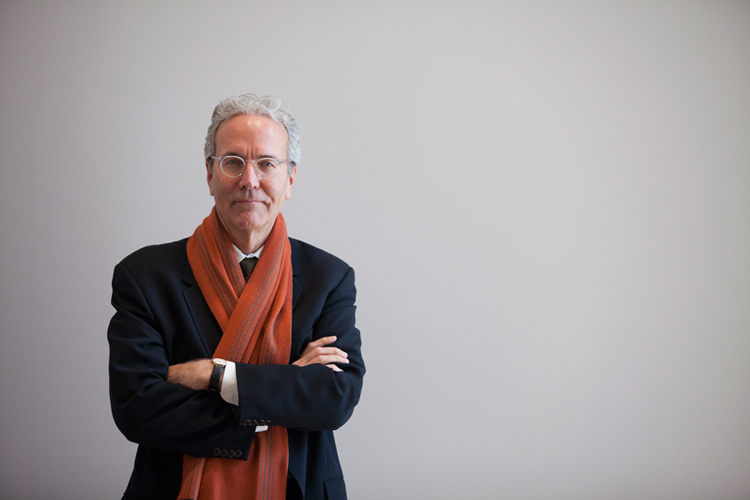The job posting for the Elizabeth and John Moors Cabot Director of the Harvard Art Museums, circulated in early 2003, didn’t sugarcoat things.
“Responsible for all aspects of care, management, and operations of the museums,” it began.
Tasks were formidable. Chief among them: “Accomplish a major renovation of the art museums’ facilities by leading successful fundraising efforts and through effective negotiations with multiple constituencies, inside and outside the university.” Also: “Inspire and support a high level of professional activity,” all while undertaking such a historic renovation and expansion project.
The individual chosen to confront the challenges—and who, fortunately, possessed the right mix of foresight and perseverance to accomplish goals of high magnitude—was Thomas W. Lentz. After 12 years on the job, he will step down July 1, 2015, leaving a legacy that will far outlive his tenure.
Lentz led the museums through a dramatic transformation, uniting the Fogg, Busch-Reisinger, and Arthur M. Sackler Museums in a majestic new facility and providing a powerful roadmap for the museums’ continued success. Working closely with the museums’ strong leadership team, he restructured internal operations, and he reinvigorated important relationships both across the university and in the local community. Harvard president Drew Faust praised his contributions as “extraordinary and enduring. . . . Tom never faltered in his dedication to this project, overcoming organizational, financial, and myriad other challenges with unrelenting—and quietly understated, yet compelling—zeal.” In recognition of Lentz’s service, the Harvard Alumni Association awarded him the Harvard Medal during this year’s Commencement exercises.
Promising Beginning
An expert in Persian painting, Lentz traces his passion for art to an undergraduate experience backpacking through Turkey and Egypt. “It was compelling, something I didn’t understand, and I like exploring the unfamiliar,” he told The Boston Globe in 2005.
While pursuing his Ph.D. in Islamic art at Harvard (he earned the degree in 1985), Lentz had an experience that would later serve him well as a museum director. As he told the Globe: “When I was a student here, I’d go up to the Islamic Department and open the drawers and take out objects and handle them. There’s no substitute for that.” Today, the museums’ expansive new Art Study Center is a testament to that powerful early exposure, and to Lentz’s deep belief in close looking and sustained study of original works of art.
Tough Work to Complete
Lentz came to the Harvard Art Museums fresh from his role as director of the Smithsonian’s international art museums division, where he oversaw the Hirshhorn Museum and Sculpture Garden, the National Museum of African Art, the Freer and Sackler Galleries, and the Cooper-Hewitt National Design Museum. There were no misconceptions that his new position would entail any less responsibility, however. Describing Lentz in a July/August 2005 profile, Harvard Magazine noted: “He hails from California, has the laid-back, wholly unstuffy style one wants of a Californian, but works 15-hour days.” Then, in a dash of humor to match Lentz’s own dry wit, added: “Good thing.”
When he arrived, the Fogg Museum’s historic 1927 building desperately needed updating. The collections needed attention, too, with contemporary art holdings in particular lagging behind other areas.
After a couple of attempts to think about alternate locations for the museums, plans shifted to a near-complete revamp of the 1927 structure at 32 Quincy Street. The renovated and expanded building, with dazzling architectural additions by world-renowned architect Renzo Piano, would join the Busch-Reisinger and Sackler Museums with the Fogg, and would add 40 percent more gallery space.
In June 2008, after extensive preparations, including the opening of a satellite facility in Somerville to house staff and nearly all of the museums’ 250,000 objects, 32 Quincy Street closed for renovations.
Finish Line and Beyond
Preparing for the new Harvard Art Museums—architecturally, financially, programmatically, and philosophically—took the next six years. Lentz led a successful fundraising campaign, and he renewed the institutional mission to focus on up-close experiences with art.
When the new museums were officially unveiled on November 16, 2014, Lentz emphasized all that was now available underneath Piano’s soaring glass roof. “There are new stories and new narratives here,” he said. “How you use these exceptional collections is up to you.”
The coming years will bear more of the fruits of Lentz’s vision and collaborative approach. The growth in the museums’ contemporary art holdings, for example, was already obvious from the moment of reopening, which featured exhibitions of Mark Rothko’s Harvard Murals and contemporary German artist Rebecca Horn’s work. The next 18 months of special exhibitions promise to expand offerings in this area.
And Lentz’s impact is clear to many beyond his staff. The museums’ visibility among the wider university community has increased significantly, with particularly active involvement among students (who, led by the Division of Academic and Public Programs, serve as the face of the museums on guided tours and in other programs) and Harvard faculty (who are teaching with objects from the museums’ collections in exciting, innovative ways).
For all of this and much more, we’re grateful to have worked alongside such a dynamic leader. Twelve years ago, the search committee was positive that Lentz was the right man for the job, and today we couldn’t agree more.


